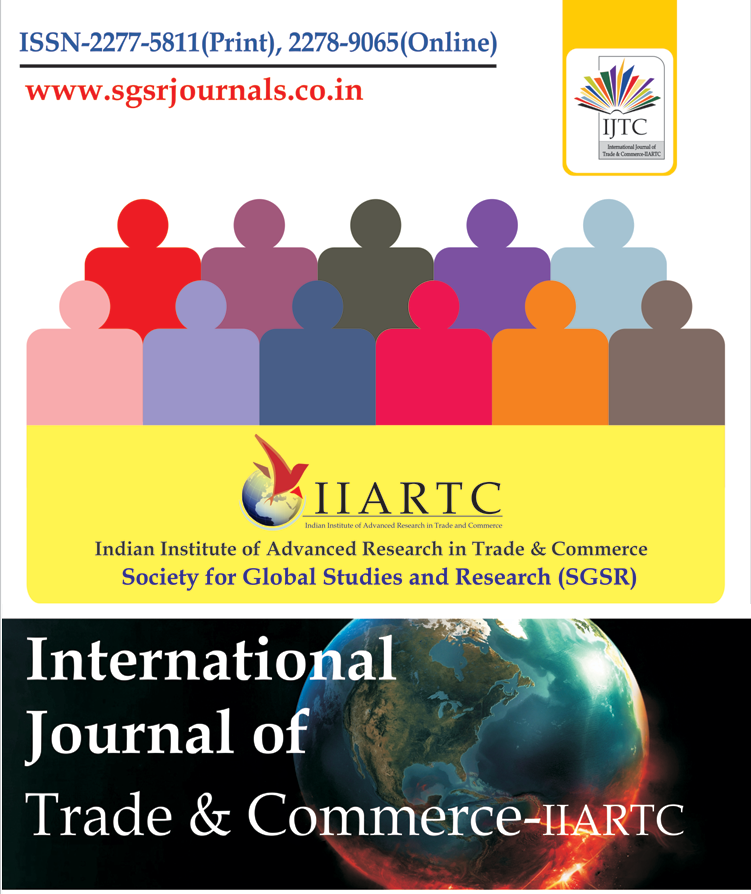Home ⇨ International Journal of Trade & Commerce-IIARTC

International Journal of Trade & Commerce-IIARTC
Impact Factor (IF):5.135 (COSMOS), IF:7.249 (ISRA), IF:3.721 (ISI)
ISSN:2277-5811 (P), ISSN:2278-9065 (O)
Frequency: Half Yearly
Job Satisfaction of Employee’s in Pharmaceutical Firms: A Case Study of Uttarakhand
In the economic development of a country Pharmaceutical sector plays a vital role. This study attempts to evaluate job satisfaction of employees in different pharmaceutical companies of Uttarakhand. It focuses on the relative importance of job satisfaction factors and their impacts on the overall job satisfaction of employees. It also investigates the impacts of pharmaceutical type, work experience, age and sex differences on the attitudes toward job Satisfaction. The result shows that salary, efficiency in work, fringe supervision and co-worker relation are the most important factors contributing to job satisfaction. The overall job satisfaction of the employees in pharmaceutical sector is at the positive level. The nature of business operation, the work culture and the level of job satisfaction have undergone lot of changes for the pharmaceutical companies. As a business proposition initiated huge investment, whereas majority of their stocks is going down bringing a high level of apprehension related to job security among its employees. This research paper highlights some of these problems and presents a picture of level of job satisfaction among employees of pharmaceutical companies. It also identifies unique issues of job satisfaction in the companies. Pharmaceuticals Companies are selected for the research because they are currently undergoing continued expansion. In order to gain competitive advantage and adapt to the dramatic changing environment, it is important for them to achieve management efficiency by increasing employee satisfaction in the organisation. Hence, this research was mainly undertaken to investigate on the significance of factors such as working conditions, pay and promotion, job security, fairness, relationship with co-workers and supervisors in affecting the job satisfaction. This paper presents a comprehensive diagnosis of job satisfaction indices of pharmaceutical business, the factors causing the dissatisfaction and suggestions to improve them.
Author:aShankar Dayal*, bDeepak Bisht
Abstract:In the economic development of a country Pharmaceutical sector plays a vital role. This study attempts to evaluate job satisfaction of employees in different pharmaceutical companies of Uttarakhand. It focuses on the relative importance of job satisfaction factors and their impacts on the overall job satisfaction of employees. It also investigates the impacts of pharmaceutical type, work experience, age and sex differences on the attitudes toward job Satisfaction. The result shows that salary, efficiency in work, fringe supervision and co-worker relation are the most important factors contributing to job satisfaction. The overall job satisfaction of the employees in pharmaceutical sector is at the positive level. The nature of business operation, the work culture and the level of job satisfaction have undergone lot of changes for the pharmaceutical companies. As a business proposition initiated huge investment, whereas majority of their stocks is going down bringing a high level of apprehension related to job security among its employees. This research paper highlights some of these problems and presents a picture of level of job satisfaction among employees of pharmaceutical companies. It also identifies unique issues of job satisfaction in the companies. Pharmaceuticals Companies are selected for the research because they are currently undergoing continued expansion. In order to gain competitive advantage and adapt to the dramatic changing environment, it is important for them to achieve management efficiency by increasing employee satisfaction in the organisation. Hence, this research was mainly undertaken to investigate on the significance of factors such as working conditions, pay and promotion, job security, fairness, relationship with co-workers and supervisors in affecting the job satisfaction. This paper presents a comprehensive diagnosis of job satisfaction indices of pharmaceutical business, the factors causing the dissatisfaction and suggestions to improve them.




